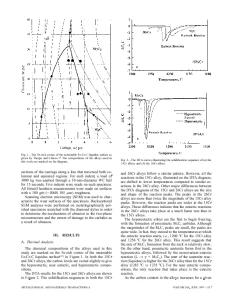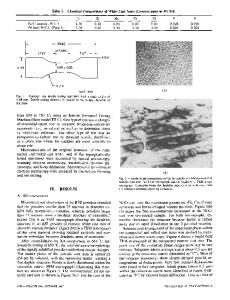Solidification and solid-state transformation mechanisms in Si alloyed high-chromium white cast irons
- PDF / 1,850,855 Bytes
- 8 Pages / 597.28 x 785 pts Page_size
- 44 Downloads / 277 Views
I.
INTRODUCTION
HIGH-chromium white cast irons (15 to 30 pet Cr) are used extensively in mining and mineral processing industries where extreme abrasion resistance is required and low toughness is sufficient, tl-51 There are two dominant microstructural features o f these irons w h i c h contribute both to their wear resistance and their toughness. Basically, the microstructure consists o f h a r d , brittle, interconnected (Cr,Fe,Mn, etc.)7C3 o r M7C3 eutectic carbides in a matrix o f austenite plus a small fraction o f martensite (as-cast). The eutectic carbides have a hexagonal crystal structure [6,7,s1 and solidify to form colonies o f rodlike or bladelike laths (eutectic "grains~). [9,10,11] Once solidified, the carbide structure and morphology are relatively immune to subsequent modification through heat treatment, t~2,13,71 In contrast, the as-cast austenitic matrix is readily heat-treated to form a mixture o f martensite/ austenite with small precipitated secondary carbides within the p r i o r austenite dendrites. [12"~3'~4] Figure 1 shows an optical micrograph o f an as-cast high-Cr white cast iron (see Table I, alloy Fe-Cr-C, for composition). The austenite dendrites appear starkly white next to the eutectic colonies o f M T C3 carbides. The martensite matrix is often preferred for many wear applications, such as gouging and l o w stress abrasion m and repetitive impact. [2,3,41 Nonetheless, the precipitation o f numerous secondary carbides during heat treatment lowers the fracture toughness o f the martensitic i r o n .t~,tSl GEORGE LAIRD II, Mechanical Engineer, i s with the Albany Research Center, United States Bureau of Mines, Albany, O R 97321. GRAHAM L.F. POWELL, Principal Research Scientist, is with the Commonwealth Scientific Research Organization (CSIRO), Woodville, South Australia. Manuscript submitted September 3 0 , 1992. METALLURGICAL TRANSACTIONS A
The authors have recently reported that secondary carbides precipitated by standard 1273 K heat treatments o f high-chromium white cast irons are either interconnected plates or rods and have suggested that the morphology o f these secondary carbides influences the mechanical and tribological properties o f heat-treated irons.t14] Thus, the microstructure o f heat-treated martensitic white cast irons has a hierarchical structure o f brittle eutectic carbides within a matrix composed o f brittle secondary carbides surrounded by a mixture o f martensite and some residual austenite. An improvement in mechanical and tribological properties o f high-Cr white cast irons is expected if the ascast austenitic matrix can b e directly transformed to martensite with reduced precipitation o f secondary carbides. One important benefit to this process would be the elimination o f the high-temperature heat treatment and its attendant problems with the thermal cracking o f large castings,t161 At r o o m temperature, the stability o f the austenite phase is due to its high Cr content (--9 to 13 pet) and high carbon content (--0.6 to 1.5 p c t ) . 02'13] Althoug
Data Loading...









